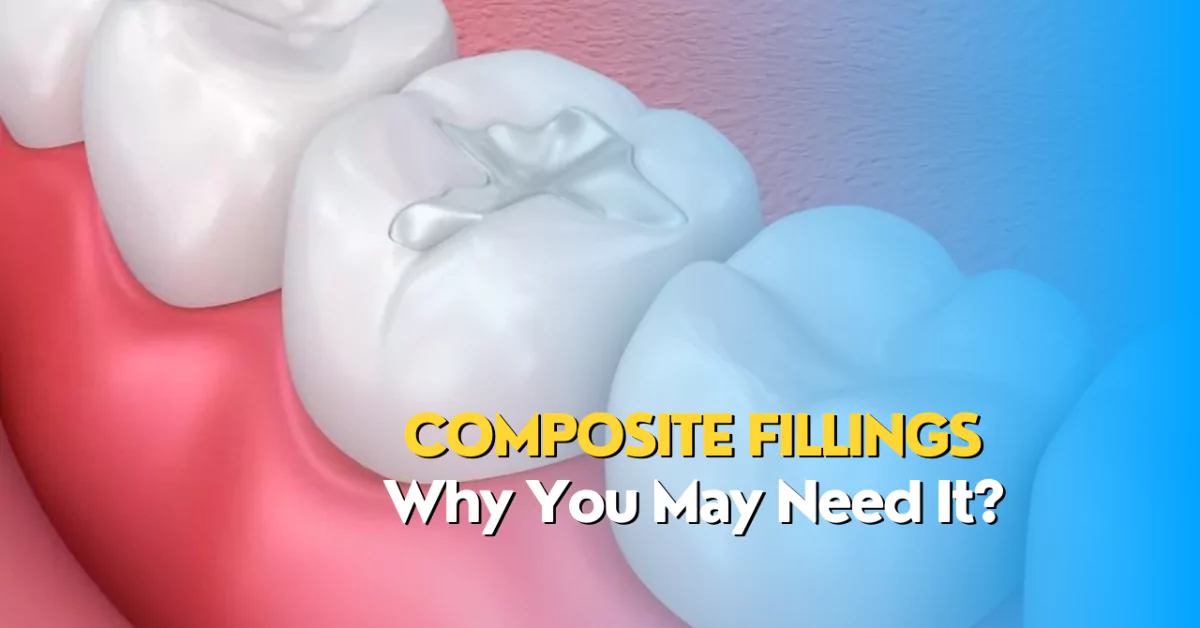Composite Fillings: Why You May Need It?
If you have a cavity in one of your teeth, you may need Composite Fillings to restore your tooth and prevent further damage. But what kind of filling should you choose? Different types of materials are available, each with its pros and cons.
The following post will focus on one of the most popular options:
Also Read: How to Avoid Dry Socket? Causes and Prevention
What are Composite Fillings?
Composite fillings are dental fillings made from a tooth-colored material called composite resin. This substance, which combines plastic (acrylic) resin and glass filler powder, can be tailored to match the color of your natural teeth.
In comparison to other fillings, composite fillings have several benefits, including:
- Composite fillings are virtually undetectable to others since they mix in with your teeth.
- Composite resin is a strong and durable material that can withstand normal chewing and biting pressure for several years.
- The amount of BPA released from composite fillings is meager and unlikely to cause harm. Composite fillings may be safer than amalgam (silver) fillings.
- Getting a composite filling is not only a cosmetic choice but also a necessary step to stop the damage caused by tooth decay.
Also Read: How Long Do Veneers Last? A Complete Guide
What Are Indirect Fillings?

Indirect fillings are another dental restoration made outside your mouth and cemented into your tooth. They are usually used when insufficient tooth structure is left to support a direct filling, such as a composite filling.
Indirect fillings can be made from composite resin, porcelain, gold, or metal alloys. There are two primary types of indirect fillings: inlays and onlays.
Inlays
Inlays are indirect fillings within your tooth’s cusps (bumps). They are used to restore large cavities or defects in the chewing surface of your back teeth. Inlays are more durable and stable than direct fillings, as they are custom-made.
Onlays
Onlays are indirect fillings that cover one or more cusps of your tooth. They are used to restore more significant areas of damage or decay that extend beyond the chewing surface of your back teeth.
Reasons for Composite Fillings
There are many reasons why you may need a composite filling, such as:
- You have a small or medium-sized cavity that does not affect the strength or function of your tooth.
- You have a cavity in a visible area of your mouth, such as your front teeth or near the gum line.
- You have chipped, cracked, or worn-down teeth that must be repaired or reshaped.
- You want to replace an old or damaged filling with a more natural-looking one.
- You are allergic or sensitive to other filling materials, such as metal or porcelain.
Composite Fillings Procedure
Getting a composite filling is a relatively painless process that can be done in one visit.
Here are the steps involved. Your dentist will:
- Check your tooth and take an X-ray to assess the extent of the decay and determine the best treatment plan for you.
- Numb the area around your tooth with a local anesthetic injection. They may also apply a numbing gel before the injection to minimize discomfort.
- Use a dental machine to remove the decayed part of your tooth and prepare it for the filling. They will also clean and dry the cavity to remove debris or bacteria.
- Apply an adhesive agent to the cavity to help the composite resin bond to your tooth. They will then place the composite resin into the hole in layers, using a special light to harden each layer.
- Shape and trim the excess material from the filling and polish it to match the surface of your tooth. They will also check your bite and make any adjustments if needed.
- Give instructions on caring for your new filling and schedule a follow-up visit if necessary.
Also Read: Tooth Sensitive to Hot and Cold: Causes and Treatments
How Long Do Composite Fillings Last?
The lifespan of composite fillings depends on several factors, such as:
- The size and location of the cavity
- The quality of the material and the placement technique
- The oral hygiene and habits of the patient
- Exposure to temperature changes, acidic foods, and beverages
On average, composite fillings can last between 5 to 10 years, but some may last longer or shorter depending on the individual case.
Are Composite Fillings Safe?
Composite fillings are generally safe and effective for most people. However, like any dental procedure, they may also have some risks and complications.
Here is a comparison of benefits and drawbacks:
Composite Fillings Benefits
- Composite fillings can replace old or damaged fillings that may be leaking, cracked, or causing discomfort.
- Composite fillings need less removal of healthy tooth structure than other fillings, as they can bond directly to your tooth.
- Composite fillings adhere well to your tooth, creating a tight seal that stops bacteria from entering your tooth.
- Composite fillings can enhance your smile by blending in with your natural tooth color.
- Composite fillings do not contain mercury which may result in allergic reactions in some people.
Composite Fillings Drawbacks
- Some people may experience temporary pain or sensitivity after getting a composite filling, especially when exposed to hot or cold stimuli.
- Some people may be allergic or sensitive to some of the ingredients in composite resin, such as acrylic resin or glass filler.
- Composite fillings may wear down, chip, crack, or stain over time due to various factors such as chewing pressure, temperature changes, acidic foods, and beverages.
Does Dental Insurance Cover the Cost of Composites?
The cost of composite fillings may vary depending on several factors, such as:
- The size and location of the cavity
- The number of teeth that need to be filled
- The experience and location of the dentist
- The type and quality of the material used
On average, composite fillings may cost between $135 and $240 per tooth, but they may range from $90 to $450 or more, depending on the case.
Dental insurance may cover some or all of the cost of composite fillings, depending on your plan and policy. However, some insurance companies may only pay for the equivalent cost of amalgam fillings, cheaper than composite fillings.
To determine how much your insurance will cover for composite fillings, contact your provider and ask about their coverage and limitations.
What’s a Temporary Filling and Why Would I Need One?
A temporary filling is a short-term solution to seal a cavity until a permanent filling can be placed. Temporary fillings are usually made from soft, easily removed materials, such as zinc oxide, eugenol, or glass ionomer.
You may need a temporary filling for various reasons, such as:
- You have a deep or large cavity that requires multiple visits to treat
- You have an infected tooth that needs root canal therapy
- You have a broken or cracked tooth that needs a crown or veneer
- You have a sensitive tooth that needs time to heal
- You have an emergency that requires immediate relief
How Should I Care for My Teeth With Fillings?
Whether you have composite or other fillings, you should take good care of your teeth and fillings to maintain oral health and prevent further problems.
Here are some tips on how to care for your teeth with fillings:
- Use fluoride toothpaste twice daily, and floss frequently.
- Regular checkups and cleanings at the dentist are advised.
- Avoid biting or chewing on foods or substances that are hard or sticky because they could harm your fillings.
- If you clench or grind your teeth at night, wear a mouthguard. Avoid smoking and consuming excessive amounts of coffee.
- If you have sensitive teeth after obtaining a filling, use a desensitizing toothpaste or gel.
- Contact your dentist immediately if you experience any issues with your fillings, including pain, sensitivity, or loose or broken fillings.
Frequently Asked Questions
Are composite fillings worth it?
Composite fillings are worth it if you want a natural-looking and durable solution for restoring your teeth. They have many advantages over other fillers, such as better aesthetics, bonding, and biocompatibility. Composite fillings also do not contain mercury or other metals that may cause health or environmental concerns.
How often do composite fillings need to be replaced?
Composite fillings must be replaced when damaged, worn out, discolored, or loose. The replacement frequency depends on several factors, such as the size and location of the filling. On average, composite fillings can last between 5 to 10 years, but some may last longer or shorter depending on the individual case.
Conclusion
Composite fillings are one of the most popular options for restoring your teeth. They have many benefits over other fillers, such as better aesthetics, bonding, and biocompatibility. However, composite fillings have drawbacks, such as potential pain or sensitivity.
If you have a cavity or a damaged tooth that needs to be filled, you should consult your dentist about the best option for you.






